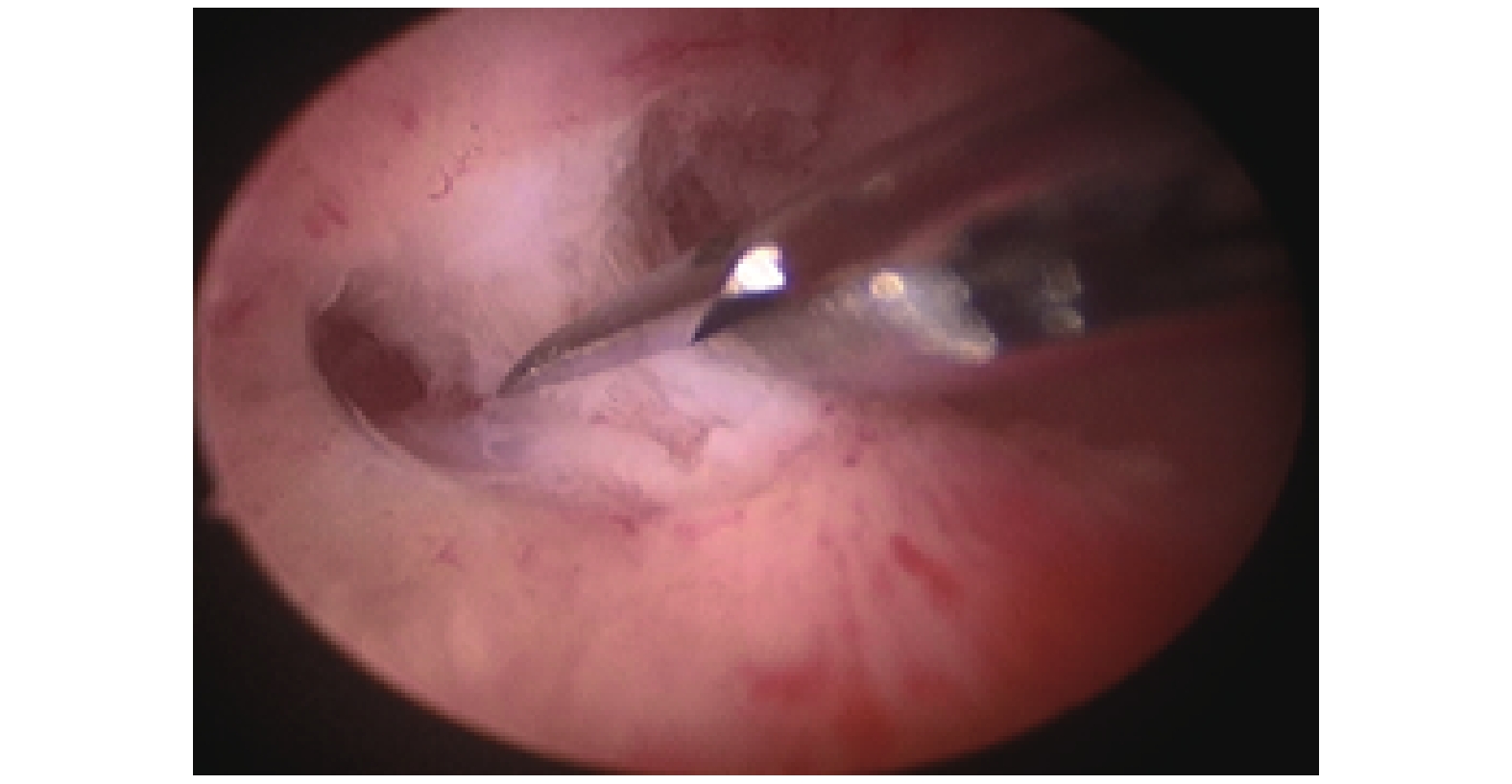Clinical Observation of HEOS in the Treatment of Moderate and Severe Intrauterine Adhesions
-
摘要:
目的 观察宫腔镜冷刀系统对拟行辅助生殖助孕的中、重度宫腔粘连患者的临床疗效及妊娠结局。 方法 回顾性分析拟行辅助生殖的中、重度宫腔粘连的患者,按手术方式不同分为冷刀组及电能量组,收集所有患者的基本资料及手术资料,并随访患者的妊娠结局。 结果 (1)共收集120例患者,其中冷刀组60例,电能量组60例。2组手术时间、术中出血量、术中并发症、术后妊娠率及活产率指标比较差异无统计学意义(P > 0.05)。其中冷刀组行2次手术后宫腔形态及内膜恢复达移植条件的占比:63.3%;电能量组占比:43.3%。术后妊娠时间冷刀组的中位妊娠月份为2.5月,要早于电能量组1月。(2)对于宫腔粘连的程度,冷刀组中、重度宫腔粘连患者的手术时间及术中出血量及术后妊娠率及活产率比较,差异无统计学意义( P > 0.05),电能量组重度宫腔粘连的患者手术时间及术中出血量均多于中度宫腔粘连,差异有统计学意义( P < 0.05)。电能量组的重度粘连病例行2次手术达移植条件的患者为所有分组中最低,仅占7.7%。 结论 对于需行胚胎移植的中、重度宫腔粘连的患者,运用宫腔镜冷刀系统手术安全、有效,且分解粘连达到满足行胚胎移植的内膜条件的手术次数相对电能量器械要更少。而对于移植后妊娠率来说,手术的方式及宫腔粘连的程度均不对妊娠率及活产率造成影响。 Abstract:Objective To observe the clinical efficacy and pregnancy outcome of hysteroscopic cold knife system in patients with moderate and severe intrauterine adhesions who planned to undergo assisted reproduction. Methods Patients with moderate and severe intrauterine adhesions who planned to undergo assisted reproduction were retrospectively analyzed and divided into cold knife group and electric energy group according to different surgical methods. The basic data and surgical data of all patients were collected, and the pregnancy outcomes of patients were followed up. Results (1) A total of 120 patients were collected in this experiment, including 60 patients in cold knife group and 60 patients in electric energy group. There were no significant differences in operation time, intraoperative blood loss, intraoperative complications, postoperative pregnancy rate and live birth rate between the two groups (P > 0.05). In the cold knife group, the proportion of the uterine cavity shape and endometrium restored to the condition of transplantation after two operations was 63.3%; Electrical energy group accounted for 43.3%. The median gestational month of the cold knife group was 2.5 months, which was 1 month earlier than that of the electric energy group. (2) To the extent to which caused by intrauterine adhesions, cold knife group, patients with severe caused by intrauterine adhesions in operative time and intraoperative blood loss and postoperative pregnancy rate and live-birth rate no statistical difference ( P > 0.05) electrical energy group of uterine cavity adhesion of surgery in patients with severe bleeding amount of time and have more moderate caused by intrauterine adhesions, and statistically significant ( P < 0.005). In the electrical energy group, only 7.7% of the patients with severe adhesions who achieved transplantation conditions after two operations were the lowest among all groups. Conclusions For the patients with moderate and severe intrauterine adhesions who need embryo transfer, the hysteroscopic cold knife system is safe and effective, and the number of operations to break down the adhesions to meet the intimal conditions of embryo transfer is less than that of electric energy instruments. For the pregnancy rate after transplantation, the method of operation and the degree of intrauterine adhesion did not affect the pregnancy rate and live birth rate. -
Key words:
- Intrauterine adhesion /
- Cold knife system /
- Diagnosis and treatment effect
-
表 1 2组患者资料[
$\bar x \pm s $ /n(%)]Table 1. The data of patients of the two groups [
$\bar x \pm s $ /n(%)]基本资料 冷刀组 电能量组 χ2/t P 年龄(岁) 31.7 ± 3.6 31.4 ± 3.9 0.283 0.779 首次手术时间(min) 26.4 ± 7.3 22.3 ± 4.5 2.756 0.010* 首次手术出血量(mL) 6.4 ± 2.8 6.4 ± 2.5 −0.050 0.961 术中并发症(n) 0 0 2次手术人数 38(63.3) 26(43.3) 0.307 0.103 术后妊娠人数 20(33.3) 16(26.7) 0.327 0.375 新生儿活产术 14(70.0) 8(50.0) 1.378 0.221 妊娠月份中位数(月) 2.5 3.5 *P < 0.05。 表 2 2组患者妊娠及产科资料(n)
Table 2. Pregnancy and obstetric data of the two groups(n)
基本资料 冷刀组 电能量组 中度宫腔粘连妊娠人数 10 8 重度宫腔粘连妊娠人数 10 8 足月妊娠分娩人数 14 8 妊娠后诊断宫外孕 2 1 妊娠后流产[n(%)] 4(20.00) 3(18.75) 妊娠后早产 0 0 产科并发症人数[n(%)] 4(20.00) 0(0.00) 表 3 60例冷刀组患者资料[
$\bar x \pm s $ /n(%)]Table 3. The data of 60 patients in the cold knife group [
$\bar x \pm s $ /n(%)]基本资料 中度粘连组 重度粘连组 χ2/t P 年龄(岁) 31.6 ± 4.4 31.8 ± 4.9 0.293 0.917 人数(n) 38 22 首次手术时间(min) 25.8 ± 7.4 27.4 ± 7.3 0.250 0589 首次手术出血量(mL) 6.1 ± 2.6 7.0 ± 3.0 1.275 0.374 2次手术人数 30(78.9) 8(21.1) 术后妊娠人数 10(26.3) 10(45.5) 0.874 0.797 新生儿活产术 8(57.1) 6(42.9) 0.789 0.703 表 4 60例电能量组患者资料[
$\bar x \pm s $ /n(%)]Table 4. The data of 60 patients in electric energy group [
$\bar x \pm s $ /n(%)]基本资料 中度粘连组 重度粘连组 χ2/t P 年龄(岁) 31.8 ± 3.5 30.1 ± 4.5 0.592 0.563 人数(n) 36 24 首次手术时间(min) 20.0 ± 2.9 25.8 ± 4.2 4.324 < 0.001 * 首次手术出血量(mL) 5.2 ± 1.3 8.3 ± 2.5 2.275 < 0.001 * 2次手术人数 24(92.3) 2(7.7) 术后妊娠人数 8(22.2) 8(33.3) 0.874 0.862 新生儿活产术 5(62.5) 3(37.5) 1.129 0.518 *P < 0.05。 -
[1] 戴霞. 宫腔镜下手术治疗宫腔粘连的临床疗效及宫腔粘连相关危险因素分析[J]. 中国现代药物应用,2017,11(15):25-27. [2] 中华医学会妇产科学分会, 宫腔粘连临床诊疗中国专家共识[J]. 中华妇产科杂志, 2015, 50(12): 881-887. [3] 段华,甘露. 宫腔粘连子宫腔整复手术质量控制[J]. 中国实用妇科与产科杂志,2022,38(1):36-40. [4] 唐庆华,高永星,施勇,等. 冷刀分离宫腔粘连术后妊娠结局相关因素分析[J]. 现代妇产科学进展,2019,28(7):514-517. [5] 中华医学会计划生育学分会. 宫腔操作前宫颈预处理专家共识[J]. 中华生殖与避孕杂志,2020,40(1):3-8. [6] 叶雅丽,艾继辉,李豫峰,等. 中重度宫腔粘连患者综合治疗的临床疗效分析[J]. 中华生殖与避孕杂志,2022,42(2):170-176. [7] 张露平,赵卫红,杨保军,等. 中重度宫腔粘连综合治疗效果[J]. 武警医学,2017,28(3):247-253. [8] Huang H,Cheng C,Johnson G,et al. Hysteroscopic intrauterine adhesiolysis using a blunt spreading dissection technique with double-action forceps[J]. J Minim Invasive Gynecol,2018,25(4):583-584. doi: 10.1016/j.jmig.2017.10.011 [9] 宫喜双,赵振,余晓玲,等. 宫腔镜操作系统冷刀微剪分离术在宫腔粘连患者临床治疗中的可行性分析[J]. 新医学,2023,54(1):66-69. [10] 周静,陈静,翁同芳,等. 宫腔镜冷刀技术在宫内疾病治疗中的应用和优势[J]. 中国内镜杂志,2019,25(1):103-107. [11] 张德喜,冯 骐,葛迎春,等. 不同手术方式切除子宫肌瘤的临床疗效比较[J]. 实用妇产科杂志,2014,30(12):950-952. [12] 何均,刁红录,张昌军,等. 宫腔镜下宫腔粘连分离术后行体外受精-胚胎移植的妊娠结局及影响因素[J]. 实用妇产科杂志,2019,35(12):941-944. [13] 李奔奔,阮玉玲,刘梅. HEOS冷刀宫腔镜系统犁田式分离中至重度宫腔粘连临床研究[J]. 实用妇科内分泌电子杂志,2019,6(13):89-90. [14] 王玉清,刘竞京,郭子珍,等. 宫腔粘连分离术后行鲜胚移植活产的影响因素分析[J]. 现代妇产科进展,2022,31(1):11-14. [15] Frantz N,Ferreira M,Kulmann M I,et al. Platelet -rich plasma as an effective alternative approach for improving endometrial receptivity - a clinical retrospective study[J]. JBRA Assist Reprod,2020,4(4):442-446. [16] 汤一群,段华,汪沙,等. 中重度宫腔粘连术后妊娠率及其影响因素分析[J]. 中国计划生育和妇产科,2017,9(1):37-41. doi: 10.3969/j.issn.1674-4020.2017.01.10 [17] 王芊芸,黄贝尔,杨慧霞. 胎盘植入发病机制的研究进展[J]. 中华围产医学杂志,2019,22(1):66-69. [18] 韩灵云,王桃,马慧敏,等. 宫腔镜下行中重度宫腔粘连分离术患者术后生殖预后比较[J]. 宁夏医学杂志,2019,41(4):350-352. [19] 杨秋美,罗相桂,张卫社,等. 妊娠12~14周完全性前置胎盘状态孕妇不同妊娠时期胎盘迁移情况及影响因素[J]. 现代妇产科进展,2021,30(11):839-842. [20] 苏进,冉翰林,杨波. 关于宫腔粘连分粘术后患者2年内妊娠及分娩情况的研究[J]. 中外女性健康研究,2021,10(19):67-68. [21] 唐诗,邢艺璇,莫蕙,等. 宫腔粘连多学科联合诊疗管理平台的构建与临床应用——全国名中医尤昭玲学术思想与临床经验研究(三)[J]. 湖南中医药大学学报,2022,42(10):1607-1611. -






 下载:
下载:









